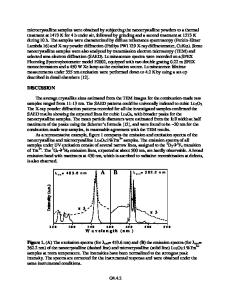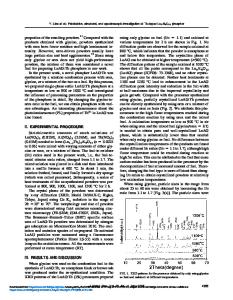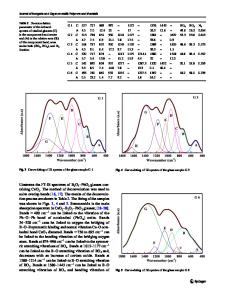Lu 2 O 3 :Eu 3+ nanoparticles and processed ceramics: Structural and spectroscopic studies
- PDF / 950,485 Bytes
- 5 Pages / 612 x 792 pts (letter) Page_size
- 68 Downloads / 326 Views
U.N. Roy, Y. Cui, and A. Burger Department of Physics, Fisk University, Nashville, Tennessee 37208 (Received 7 February 2004; accepted 9 June 2004)
Europium-doped lutetium oxide (Lu2O3:Eu3+) nanophosphors were synthesized via modified combustion technique using urea as the fuel and metal nitrates as oxidants. The pellets prepared from the calcined nanocrystalline powders were vacuum sintered up to 1750 °C leading to very translucent ceramic. The products were characterized by x-ray diffraction to ascertain phase purity. The microstructures reveal the nanocrystalline nature of the powders. We have illustrated the crystallite size dependence and the influence of Eu3+ activation of Lu2O3:Eu3+ nanophosphors on Raman scattering. We have also demonstrated the particle size dependence of emission characteristics of nanophosphors and ceramics. Our results suggest that although the processed ceramics display superior emission characteristics, the nanocrystalline phosphor powders calcined at 1100 °C also display reasonably good emission characteristics, illustrating the possibility of their applications in display technology.
I. INTRODUCTION
Lanthanide-based phosphors and scintillators have been emerging rapidly in recent years. It is anticipated that oxide phosphors, such as Eu-doped Y2O3 have the potential of replacing the conventional displays.1–9 On the other hand, Eu-doped Lu2O3 is an important x-ray phosphor for digital radiographic imaging.10–12 Although Lu2O3 is a structural analog of Y2O3, the major advantage of Lu2O3 over Y2O3 is its phenomenally high density, reaching 9.42 g/cm2, which lead to a high stopping power for x-ray and other types of ionizing radiations. In a typical radiation detection system, the scintillator plays an important role of converting the incident energy of the ionizing radiation into scintillation light photons whose emitted lights are collected by the photosensors. The challenging task is to fabricate a scintillator with high light output, fast decay, and very low afterglow. Due to 5 D0 → 7F2 transitions within europium, Lu2O3:Eu3+ shows luminescent properties and emits red light with a wavelength of 611 nm;13 it can be used as a red phosphor and a scintillator as well. Hence, extensive research is currently underway to develop rare-earth-based oxide phosphors for superior performance. The synthesis and study of nanocrystalline materials
have been a major research interest in recent years due to far superior powder properties, such as large surface area, high sinterability at lower temperature, and tuning of various properties related to a transition from solid-state matter to molecular structures as the particle size is scaled down to nanoscale. Consequently, such materials usually exhibit novel optical, electronic, and magnetic properties. To optimize the synthesis procedure for the significant enhancement in luminescent properties of doped lanthanides, several novel techniques10,11 have been contemplated. Combustion synthesis is one of the extremely time and energy efficient techni
Data Loading...











